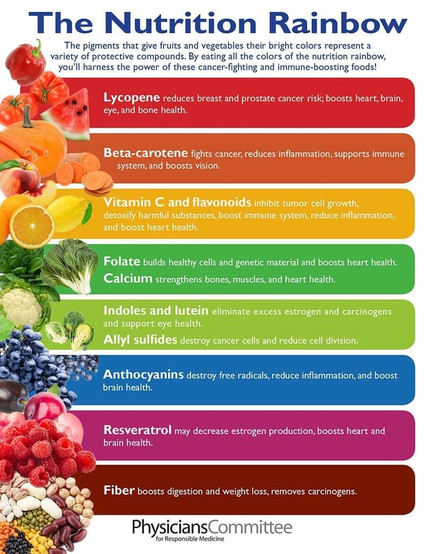Eat RAINBOW
- Dr. Oksana Nimkevych
- Jul 5, 2021
- 3 min read
WHITE
White, tan and brown fruits and vegetables may not be the brightest produce in your basket, but what they lack in vibrant color they make up for in powerful phytonutrients. Garlic, onions, scallions and leeks are rich sources of organosulfur compounds such as ALLICIN, which is responsible for their pungent aroma as well as incredible health benefits. Allicin may help lower cholesterol and blood pressure. Scientists are also interested in its ability to help the body fight infections and stimulate the immune system.
Cabbage : Nutrients in cabbage – strengthen bones and maintain healthy blood vessels.
Cauliflower, like other members of the cruciferous family, contains INDOLES and ISOTHIONATES, compounds that protect from oxidative street.
Mushrooms: cholesterol and gluten-free and they are filling, so they are great for weight loss. Rich in beta-glucans which support your immune system, help prevent cancer, regulate cholesterol and help control blood sugar.
All mushrooms contain vitamin D, they have the unique ability to increase vitamin D amounts due to UV-light or sunlight exposure. Similar to humans, mushrooms naturally produce vitamin D following exposure to sunlight or a sunlamp: mushrooms’ plant sterol – ergosterol – converts to vitamin D when exposed to light.
Garlic: Garlic can promote hair growth, fight colds and flu, boost the immune system and minimize acne. Selenium, cofactor for reduction of antioxidant enzymes, such as glutathione peroxidases and certain forms of thioredoxin reductase. Again oxidative stress.
Onions: Onions have anti-inflammatory properties that can help with arthritis as well as boost your immune system, decrease triglycerides and reduce cholesterol levels, reduce high blood pressure and protect against blood clots, reduce your risk of heart disease and diabetes.
Potatoes: Potatoes are loaded with fiber, which is great for improving cholesterol, feeling full and essential for heart health. Potatoes also contain vitamin C, vitamin B6 and magnesium.
YELLOW
Yellow fruits and vegetables house phytochemicals, antioxidants, vitamins and minerals that can combat against severe illnesses and heart issues. And let’s not forget about the skin! A very special phytochemical called bio-flavonoid (Vitamin P), greatly improves absorption and bioavailability of vitamin C that the skin needs, in order to replenish itself. They also contain carotenoids. We invest loads of money in skincare products and anti-ageing cream, oblivious to the fact that yellow food is extremely rich in retinol, a type of Vitamin A1 that acts upon acne and wrinkles in order to reverse the damage.
Share your list of yellow fruits and vegetables that you incorporate in your daily meals to maximise skin benefit.
For more information check out Instagram page
RED Red fruits and vegetables are nature's powerhouse on nutrition and benefits. Containing phytochemicals – including lycopene and ellagic acid – red foods have cancer-fighting benefits, could reduce the risk of diabetes and heart disease, and a host of other benefits. Watermelon is surprisingly even higher in lycopene than tomatoes.
Healthy red foods include tomatoes, red pepper, red onions, radish, red beans, beets, strawberries, raspberries, cranberries, watermelon, rhubarb, red apples, cherries, and pomegranate.
What are your favorite reds and what reds did you eat last week?
BLUE AND PURPLE
Anthocyanin is a blue-purple pigment that can cross the blood-brain barrier and improve brain blood flow, protects against degenerative diseases, improves cognition and mood.
Phytonutrients in purple foods: anthocyanins flavonoids phenolic acids proanthocyanidins pterostilbene resveratrol anthocyanidins stilbenes
Which ones would you like to learn more about? Ask!
Also some additional info on our Instagram
ORANGE
Orange vegetables and fruits are nutritional powerhouses, and all are relatively low in calories. They contain significant amounts of:
Vitamin K Vitamin A Vitamin C Potassium Fiber
Beta carotene is the antioxidant that gives foods such as carrots, sweet potatoes, cantaloupes and pumpkins their orange color (lower levels of beta-carotene are also found in yellow and dark green fruits and vegetables).
Beta carotene is converted in the body to Vitamin A, which is helpful for vision, skin, teeth and bones. Emerging research suggests vitamin A may provide some protection against autoimmune diseases, such as type 1 diabetes, lupus and multiple sclerosis.
Scientists believe that damaged DNA may be the root cause of many cancers, but certain antioxidants can keep free radicals from harming the DNA in cells. The beta-carotene is one such antioxidant.
Two particular carotenoids, lutein and zeaxanthin, are important for eye health. They reduce the risk of cataracts and age-related macular degeneration. Carrots and bell peppers contain these carotenoids. Vitamin A also increases your eyes' ability to function in low-light conditions.
Research suggests eating more high-carotenoid foods may help prevent excess fat storage, especially around your midsection. It's also well-established that leaner people have higher blood levels of carotenoids.







Comments